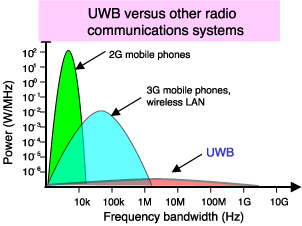
Title: Ultra Wide Band (UWB) Frequency : A Study and Review Paper
Authors: D.Amrutha & K.Maneesha, 2nd Year BTech, ECE Department
College: Prakasam Engineering College, Kandukur
Introduction:
Ultra-wideband (also known as UWB, ultra-wide band and ultraband) is a radio technology pioneered by Robert A. Scholtz and others which may be used at a very low energy level for short-range, high-bandwidth communications using a large portion of the radio spectrum.[1] UWB has traditional applications in non-cooperative radar imaging. Most recent applications target sensor data collection, precision locating and tracking applications.
Similar to spread spectrum, UWB communications transmit in a manner which does not interfere with conventional narrowband and carrier wave used in the same frequency band.
Ultra-wideband is a technology for transmitting information spread over a large bandwidth (>500 MHz); this should, in theory and under the right circumstances, be able to share spectrum with other users. Regulatory settings by the Federal Communications Commission (FCC) in the United States intend to provide an efficient use of radio bandwidth while enabling high-data-rate personal area network (PAN) wireless connectivity; longer-range, low-data-rate applications; and radar and imaging systems.
Ultra wideband was formerly known as “pulse radio”, but the FCC and the International Telecommunication Union Radiocommunication Sector (ITU-R) currently define UWB in terms of a transmission from an antenna for which the emitted signal bandwidth exceeds the lesser of 500 MHz or 20% of the center frequency. Thus, pulse-based systems—where each transmitted pulse occupies the UWB bandwidth or an aggregate of at least 500 MHz of narrow-band carrier; for example, orthogonal frequency-division multiplexing (OFDM)—can gain access to the UWB spectrum under the rules. Pulse repetition rates may be either low or very high. Pulse-based UWB radars and imaging systems tend to use low repetition rates. On the other hand, communications systems favor high repetition rates, thus enabling short-range gigabit-per-second communications systems. Each pulse in a pulse-based UWB system occupies the entire UWB bandwidth, unlike carrier-based systems which are subject to deep fading and intersymbol interference.
Technology:
One performance measure of a radio in applications such as communication, locating, tracking and radar is the channel capacity for a given bandwidth and signaling format. Channel capacity is the theoretical maximum possible number of bits per second of information which may be conveyed through one or more links in an area. By virtue of the large bandwidths inherent in UWB systems, large channel capacities could be achieved in principle without invoking higher-order modulations requiring a very high SNR. Ideally, the receiver signal detector should match the transmitted signal in bandwidth, signal shape and time.
Forward error correction – used in high-data-rate UWB pulse systems – can provide channel performance approaching the Shannon limit. OFDM receivers typically fix most errors with a low density parity check code inner code followed by some other outer code that fixes the occasional errors (the “error floor”) that get past the LDPC correction inner code even at low bit-error rates.
Multipath interference is a problem in narrowband technology. It also affects UWB transmissions, but according to the Shannon-Hartley theorem and the variety of geometries applying to various frequencies the ability to compensate is enhanced. Multipath causes fading, and wave interference is destructive.
Antenna systems:
Distributed MIMO: To increase the transmission range, this system exploits distributed antennas among different nodes.
Multiple-antenna: Multiple-antenna systems (such as MIMO) have been used to increase system throughput and reception reliability. Since UWB has almost impulse-like channel response, a combination of multiple antenna techniques is preferable as well. Coupling MIMO spatial multiplexing with UWB’s high throughput gives the possibility of short-range networks with multi-gigabit rates.
Applications: Ultra-wideband characteristics are well-suited to short-distance applications, such as PC peripherals. Due to low emission levels permitted by regulatory agencies, UWB systems tend to be short-range indoor applications. High-data-rate UWB may enable wireless monitors, the efficient transfer of data from digital camcorders, wireless printing of digital pictures from a camera without the need for a personal computer and file transfers between cell-phone handsets and handheld devices such as portable media players. UWB is used for real-time location systems; its precision capabilities and low power make it well-suited for radio-frequency-sensitive environments, such as hospitals. Another feature of UWB is its short broadcast time.
Ultra-wideband is also used in “see-through-the-wall” precision radar-imaging technology, precision locating and tracking (using distance measurements between radios), and precision time-of-arrival-based localization approaches. It is efficient, with a spatial capacity of approximately 1013 bit/s/m². UWB radar has been proposed as the active sensor component in an Automatic Target Recognition application, designed to detect humans or objects that have fallen onto subway tracks.
CONCLUSION:
The recent spurt of investigations, investments, and regulatory rulings indicate an exploding interest in Ultra Wideband technology. Though most signs point to a promising future for UWB, there is little experience yet with the effects of multiple UWB transmitters in the real world. It uses a unique type of signal (the RF doublet) in a unique way (low power pulses over a very large bandwidth). The technology must overcome concerns about interference with safety-of-life signals before achieving complete acceptance. Successful operation without interference will certainly lead to numerous anticipated applications and an entirely new face of Wireless communication
REFERENCES:
Fleming, R., and Kushner, C. (10 September 2001). CMOS Ultra-Wideband CMOS Ultra-
Wideband Localizers for Networking in the Extreme. Presentation to DARPA. Retrieved March 10, 2002 from www.darapa.mil.
J.H. Reed, Introduction to Ultra Wideband Communications Systems. New Jersey: Prentice Hall PTR, 2005.
http://en.wikipedia.org/wiki/Ultra-wideband
www.pcquest.com
www.extremeuwb.com
www.wimedia.com
